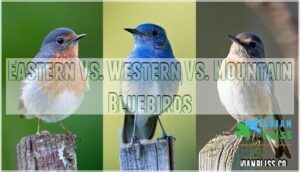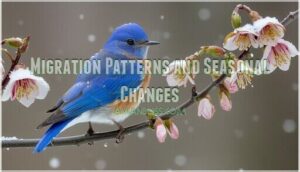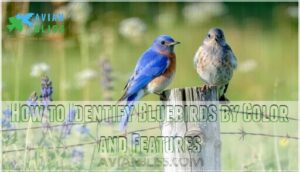This site is supported by our readers. We may earn a commission, at no cost to you, if you purchase through links.

Once you know why some bluebirds turn heads while others blend, spotting those color clues becomes a knack you can hone. Start noticing, and suddenly every flutter reveals a story about what shapes the color living in a bluebird’s wings.
Table Of Contents
- Key Takeaways
- Why Some Bluebirds Are Bluer Than Others
- Bluebird Species and Their Color Variations
- How to Identify Bluebirds by Color and Features
- Factors Affecting Bluebird Plumage Brightness
- Attracting The Bluest Bluebirds to Your Yard
- Frequently Asked Questions (FAQs)
- What makes a bluebird blue?
- Is the male or female bluebird more blue?
- What birds are mistaken for bluebirds?
- What are the three types of bluebirds?
- What optical phenomenon creates bluebirds blue coloration?
- How do bluebirds feathers scatter light to appear blue?
- Do bluebirds eggs have any unique characteristics or colors?
- How do bluebirds nanostructures contribute to their blue hue?
- Can bluebirds colors be affected by their diet or environment?
- Do bluebirds change color as they age?
- Conclusion
Key Takeaways
- Bluebirds’ blue feathers come from microscopic feather structures that scatter light, not from pigments.
- Genes, diet during molting, and environmental conditions all play a role in how vivid a bluebird’s color appears.
- Male bluebirds are typically more brightly colored than females, which helps them attract mates while females camouflage for nesting.
- Three main bluebird species—Eastern, Western, and Mountain—show distinct shades of blue, with each species’ color influenced by region and habitat.
Why Some Bluebirds Are Bluer Than Others
If you’ve ever noticed that some bluebirds seem brighter than others, you’re not alone. There are a few key reasons behind these color differences.
Let’s take a closer look at what really shapes their vivid blue.
The Science of Bluebird Feather Color
If you’ve ever wondered why a bluebird’s feathers seem to glow with an almost electric color, you’re not alone. The answer lies in a blend of avian biology and genetic inheritance.
In the Eastern Bluebird (Sialia sialis) and other species, plumage brightness isn’t just about pigment. Instead, feather nanostructures, dietary impact, and UV ornamentation all work together to shape these striking bird species characteristics.
Nanostructures and Light Reflection
You might think blue feathers get their brilliance from pigment, but Avian Biology tells a different story. The secret lies in nanostructures: a spongy layer of keratin scatters light, producing intense blues through Spectral Reflectance.
Factors like Spongy Layer Thickness and Melanin Distribution explain subtle shade differences—making Bird Identification and comparisons among Bluebird Species truly fascinating. These differences are likely due to recent evolutionary changes.
Genetics and Inheritance of Color
While nanostructures shape every feather’s color, Genetics put your Eastern Bluebird’s “blue” on full display. Think of these elements as a blueprint for vividness:
- Gene Expression sets baseline hue.
- Allelic Variation brings genetic diversity.
- Mendelian Inheritance guides each generation’s color.
- Major Genes like MC1R play key roles.
- Selective Dynamics shape what you see. The blue gene dilutes black feathers.
Environmental and Dietary Influences on Plumage
Of course, even a bluebird with all the right genes needs the right food and environment to show off its brightest feathers. A rich avian diet—think insects, mealworms, and berries—fuels feather development during molt.
Poor habitat or pollution can dull plumage. Climate change shifts available nutrition, so proper molt nutrition and local habitat impact overall diet and color.
Bluebird Species and Their Color Variations
Not all bluebirds wear the same shade of blue. You’ll notice differences from one region and species to the next.
Here’s how these variations stack up across the main types you’re likely to see.
Eastern Vs. Western Vs. Mountain Bluebirds
Not all bluebirds wear the same shade of blue—once you know how to spot the differences among the Eastern, Western, and Mountain species, you’ll start seeing an entire spectrum on the wing.
Each bluebird species reveals subtle clues: Eastern Bluebirds show rusty breasts, Western Bluebirds sport blue throats, and Mountain Bluebirds are nearly all sky-blue—useful distinctions for species identification and bird identification alike.
Regional Differences in Bluebird Coloration
Wherever you go, you’ll spot a unique Plumage Hue Gradient among bluebird species—shaped by more than just distance.
The shifting colors across different regions are shaped by:
- distinct Feather Nanostructure,
- Genetic Subspecies,
- Environmental Stressors,
- Diet Composition, and
- location-specific cues.
From the Eastern Bluebird’s deep blue to Mountain Bluebird’s pale, regular bird identification becomes a study in geography.
Migration Patterns and Seasonal Changes
As you watch bluebirds respond to migration triggers, remember their suit of blue isn’t static. During breeding seasons, birds may display richer blue. When migration patterns shift them toward winter ranges, climate impacts and molting patterns can dull or brighten their color.
Bird migration patterns aren’t just about movement—they gently sculpt bluebird shades throughout every season.
How to Identify Bluebirds by Color and Features
Spotting a bluebird isn’t just about the color—you need to know what to look for. Differences between males, females, and young birds can make things tricky.
Here’s how you can tell them apart by their plumage and features.
Male Vs. Female Plumage Differences
If you’ve ever wondered who’s who among bluebirds, try looking for a bird dressed in a vivid blue jacket—it’s almost always the male showing off.
This plumage dimorphism is striking across Eastern, Western, and Mountain Bluebird species: males use intense color as breeding signals, while females favor camouflage for nest safety, aiding bird identification and mate selection.
Juvenile and Adult Coloration
Think of a young bluebird as a teenager in drab clothes, waiting to get that first vivid blue suit as it grows into adulthood. During this period, you’ll spot key differences shaped by Fledgling Plumage, the Molting Process, and Color Maturation:
- Dull speckling on fledglings aids camouflage
- Gradual color deepening with age-related changes
- Molting process triggers brighter feathers
- Subspecies variation affects shade and timing
- Adult Eastern Bluebird males develop striking blue
Mastering these details sharpens your bird identification skills and grows your understanding of avian biology.
Distinguishing Bluebirds From Similar Birds
Spotting a flash of blue in the trees can feel like finding a hidden gem—so how can you be sure it’s a bluebird and not one of their look-alike neighbors? Focus on coloration mimicry, song identification, and behavioral differences. Use handy tools like the Audubon Field Guide for confident ID, especially when habitat overlap and bird size comparison muddy the waters below.
| Bird Species | Key Coloration Features | Habitat Overlap |
|---|---|---|
| Eastern Bluebird | Rusty breast, blue back | Open fields, gardens |
| Western Bluebird | Blue throat, orange sides | Forest edges, farmlands |
| Mountain Bluebird | All-over sky blue | High plains, mountain meadows |
Factors Affecting Bluebird Plumage Brightness
A bluebird’s color isn’t just a twist of genetics or luck. Several important factors work together to shape how bright or dull their feathers appear.
Let’s take a closer look at what truly influences that famous blue.
Food Availability During Molt
As young birds grow new feathers, having plenty of good food on hand can make all the difference in how bright their blue turns out. During molt, a diet high in insects and berries aids proper feather development and color intensity. Here’s why molting nutrition matters:
- Insect abundance fuels feather growth.
- Nutrient-rich food sharpens blue hues.
- Dietary impact shapes plumage quality.
- Reliable feeding behavior ensures lasting color.
Health, Stress, and Feather Quality
Every feather tells a story—from bacterial feather degradation to the subtle effects of oxidative stress and noise pollution. Even heavy parasite loads or daily feather wear can dull your bluebird’s sparkle. In avian biology, the brightest blues reveal more than diet; they offer a visible peek into your bird’s ecology, health, and behavior.
| Challenge | Impact on Feather Color | Bird’s Response |
|---|---|---|
| Parasite load effects | Dull, patchy feathers | Extra preening |
| Oxidative stress | Faded blue hues | Antioxidant-rich diet |
| Noise pollution impact | Stressed, poor feather growth | Relocate, adapt |
Parental Investment and Chick Development
Just as a bluebird’s shine can hint at its health, it also reflects how much care and energy parents pour into raising their chicks.
High feeding frequency and longer parental care duration boost nestling growth rates, improving fledgling success rates.
From the moment eggs are laid until the young birds take flight, attentive parenting and a nutritious diet help shape how much fledglings rely on their parents—and, in the end, the vividness of their feathers.
Attracting The Bluest Bluebirds to Your Yard
If you want to see the brightest bluebirds around, it helps to set things up just right in your own backyard. A few smart changes can make your space more inviting for these colorful birds.
Here’s what you’ll want to think about when picking out the best enclosure options.
Creating Ideal Bluebird Habitats
It doesn’t take a magical meadow to welcome bluebirds—just the right mix of open space, shelter, and a few thoughtful touches in your own backyard.
Prioritize native plant selection for natural food and cover, position birdhouses to balance nest box placement with predator deterrents, and add a consistent water source.
Remember, wildlife habitat creation also means considering bluebirds’ winter habitat needs.
Best Practices for Nest Box Installation
While a simple wooden box might seem enough, a nest box tucked at the right height and facing away from strong winds gives bluebirds their best shot at feeling right at home.
Use untreated wood and a 1.5-inch hole size to keep out starlings.
Add predator guards, practice regular monitoring protocols, and keep birdhouses spaced to avoid defending nesting cavities.
Providing Proper Nutrition for Vibrant Plumage
If you’ve ever wondered why some bluebirds seem to glow a little brighter, the secret almost always starts with what they eat. Mealworm supplementation, a spread of berry varieties, and insect diversity—especially during molting diets—are essential. Add calcium sources in spring.
Offering a menu rich in Avian Diet and Nutrition encourages eye-catching feather quality. Even your bird feeding habits matter.
Supporting Bluebird Conservation Efforts
When you invest in bluebird conservation efforts, you extend your impact far beyond your backyard. Supporting bird conservation means:
- Participating in citizen science platforms like eBird
- Advocating for wildlife conservation legal frameworks
- Promoting grant opportunities and population trends research
- Backing reintroduction successes and trail monitoring projects
Your involvement ensures bluebirds thrive—now and for future generations.
Frequently Asked Questions (FAQs)
What makes a bluebird blue?
Have you ever wondered why the blue on bluebirds looks so vivid? Their Feather Nanostructure scatters light, amplifying blue wavelengths.
Together with their genetic makeup and what they eat, these factors determine how bright a bird’s feathers appear and how much ultraviolet light they reflect.
Is the male or female bluebird more blue?
Between the sexes, male bluebirds consistently display brighter blue plumage than females.
In Avian Biology, this Male vs. Female difference—called Bluebird Dimorphism—plays a Plumage Purpose in mate selection, especially among Eastern, Western Bluebird, and Mountain Bluebird populations.
What birds are mistaken for bluebirds?
Swallows swoop low, Indigo Buntings flash vibrant blue, and even some sparrows fool keen eyes.
Similar bird species, coloration confusion, and overlapping habitats challenge birdwatching, making bluebird identification about more than size comparison or behavior patterns.
What are the three types of bluebirds?
You’ll find three main types: the Eastern Bluebird, Western Bluebird, and Mountain Bluebird.
Each species has unique plumage and habitat preferences—an essential starting point for any birdwatching adventure or deeper dive into avian biology.
What optical phenomenon creates bluebirds blue coloration?
Feather nanostructures in bluebirds act like tiny prisms, creating blue coloration by light scattering and structural coloration.
This optical phenomenon reflects blue wavelengths, making bluebirds stand out in avian biology, avian ecology, and bird behavior discussions.
How do bluebirds feathers scatter light to appear blue?
Within feather nanostructure, tiny channels scatter light, amplifying blue wavelengths while absorbing others. This color production relies on light scattering, not pigment, making avian biology unique.
Ornithology unlocks how avian behavior shapes what you see—true magic without dye.
Do bluebirds eggs have any unique characteristics or colors?
Peek inside a bluebird nest and you’ll spot smooth, pale blue eggs—sometimes white—tucked in a tidy clutch.
Their thin eggshell color, clutch size, and careful incubation period all hint at fascinating Bluebird Nesting Habits in avian biology.
How do bluebirds nanostructures contribute to their blue hue?
Bluebirds’ feather channel networks—tiny nanostructures—scatter light, bouncing only blue wavelengths back to your eyes.
This structural coloration, not pigment, explains their vivid hue, as confirmed by ornithological research into avian biology and plumage.
Can bluebirds colors be affected by their diet or environment?
Dietary impact and habitat influence play key roles in bluebirds’ color vibrancy. During molt coloration, access to nutritious insects or berries, and absence of environmental toxins, directly shapes wildlife diet and nutrition, affecting bluebirds’ feather coloration.
Do bluebirds change color as they age?
Think of a young painter swapping plain brushes for vibrant ones—juvenile bluebirds start with muted colors, but through juvenile molting and plumage maturation, their feathers brighten.
Over time, age-related pigmentation and natural color fading may gently soften those hues.
Conclusion
A single flash from the “bluest” bluebird can look as if the sky itself cracked open and spilled out feathers. Bluebirds bluer than others aren’t just a quirk of genetics; they’re nature’s declaration that details matter.
Some bluebirds shine so vividly blue, it’s as if the sky itself burst open just to let them fly
Spotting the differences—thanks to nanostructures, diet, and environment—takes patience, but the payoff is a new layer of understanding outside your window. Let yourself wonder boldly, and every blue wing you see becomes a lesson in what makes life vivid.
- https://www.sde.idaho.gov/academic/science/files/handouts/There's-No-Such-Thing-as-a-Blue-Bird.pdf
- https://www.acsh.org/news/2016/06/30/blue-birds-arent-blue-this-is-how-they-fool-you
- https://www.pnas.org/doi/10.1073/pnas.2217692120
- https://biology.appstate.edu/research-facilities/siefferman-lab/research/plumage-signals-sexual-selection
- https://poultrykeeper.com/poultry-breeding/genetics-blue-birds/









